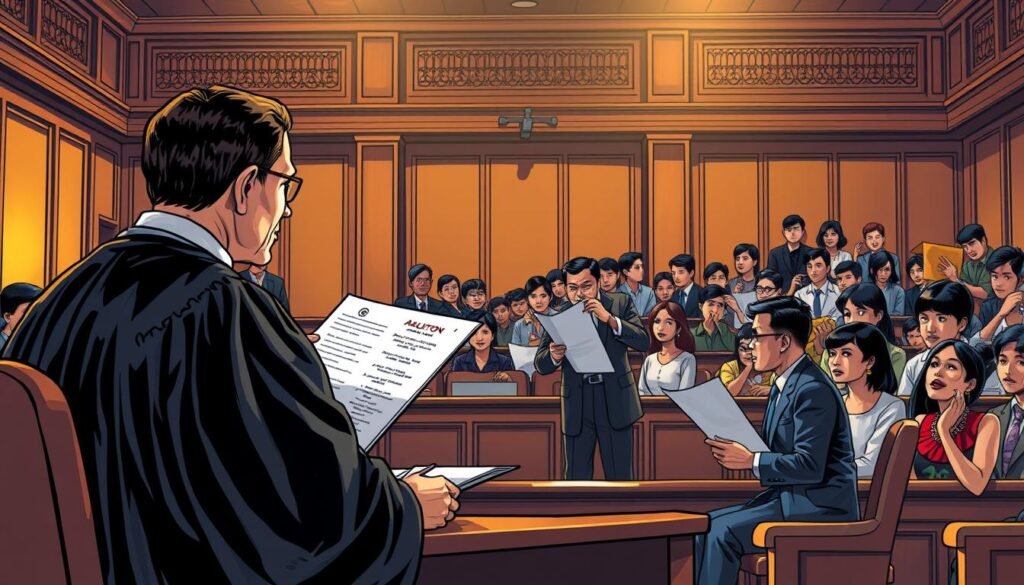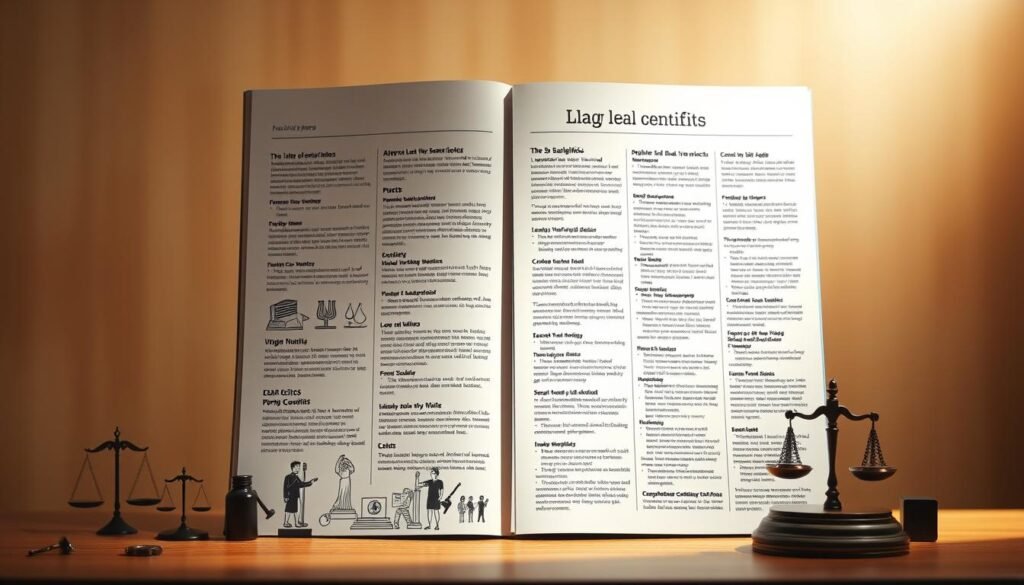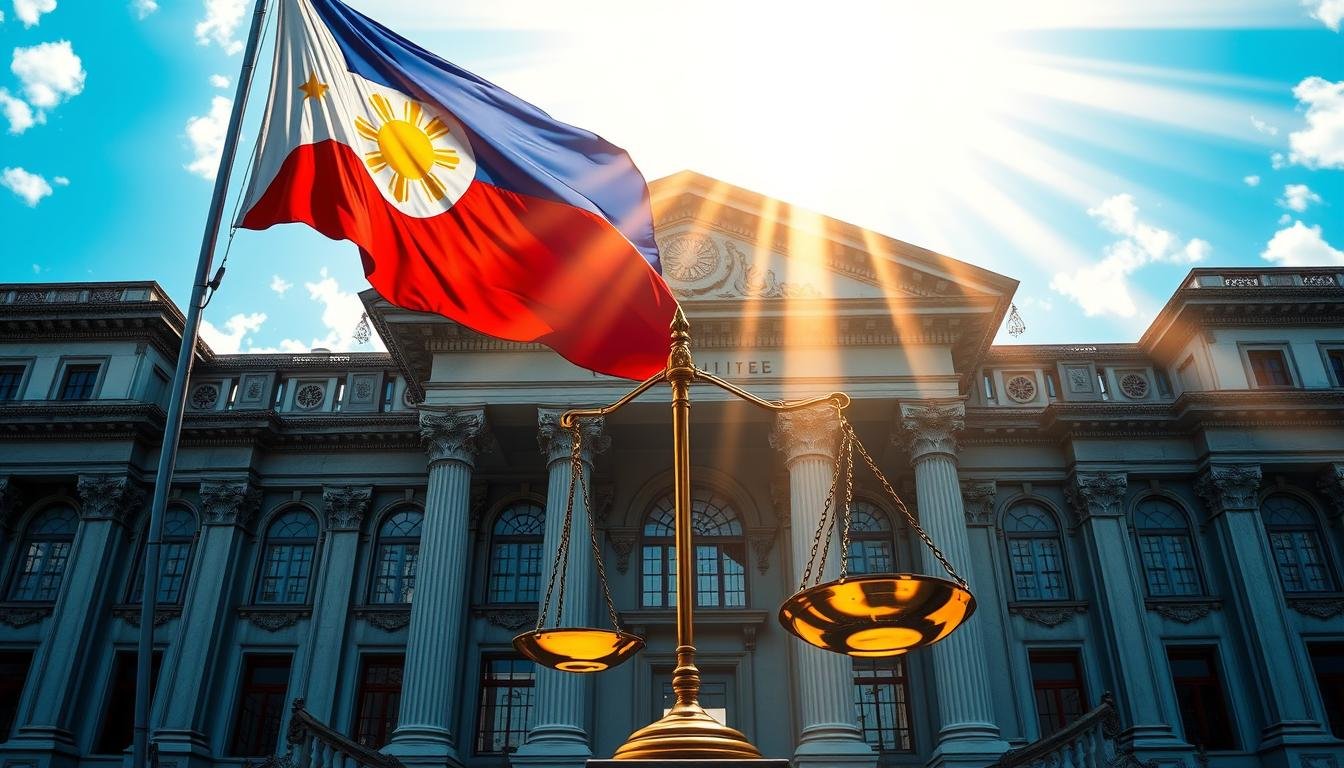The American legal system has left a lasting mark on the Philippines, shaping its governance and law practices. From the early 20th century, when the U.S. introduced its judicial framework, the Philippines adopted many principles that remain relevant today.
For example, the Philippine Constitution mirrors the U.S. Bill of Rights, ensuring fundamental freedoms. The Supreme Court structure, with 15 justices, also reflects the American model. These adaptations highlight the deep connection between the two systems.
Understanding this influence is crucial for grasping the nuances of Philippine governance. It also provides insights into how business and societal norms have evolved. By examining these parallels, we can better appreciate the shared legal heritage and its ongoing impact.
Key Takeaways
- The Philippine Constitution is heavily influenced by the U.S. Bill of Rights.
- The Supreme Court structure in the Philippines mirrors the American model.
- American legal principles have shaped Philippine governance and law practices.
- This influence extends to business regulations and societal norms.
- Studying these parallels helps understand the shared legal heritage.
Introduction to the American Legal Influence in the Philippines
The Philippines’ judicial framework underwent significant transformation under American governance. From the early 20th century, the U.S. introduced reforms that reshaped the court structure and legal proceedings. This influence remains evident in the modern Philippine judicial system.
One of the most notable changes was the adoption of foundational rights and principles. The U.S. introduced concepts like due process and equal protection, which became integral to the Philippine Constitution. These principles ensured fairness and justice in legal proceedings.

Traditional Philippine legal norms, rooted in Spanish colonial practices, contrasted sharply with American ideals. The U.S. emphasized an adversarial system, where opposing parties present their cases before an impartial judge. This approach replaced the more inquisitorial methods previously used.
Historical events during the American period cultivated a unique blend of legal practices. For example, the establishment of the Philippine Assembly in 1907 marked the beginning of legislative reforms. These changes laid the groundwork for a more structured and transparent court system.
The importance of judicial and legislative reforms during this era cannot be overstated. The U.S. introduced measures to ensure independence and fairness in the judiciary. These reforms included the establishment of a Supreme Court modeled after the American counterpart.
Reforms in legal rights and court structures were driven by American criteria. The U.S. aimed to create a system that upheld individual freedoms while maintaining order. This approach significantly influenced the development of Philippine governance and societal norms.
| Aspect | Traditional Philippine Norms | American Legal Ideals |
|---|---|---|
| Court Structure | Inquisitorial | Adversarial |
| Legal Rights | Limited individual protections | Emphasis on due process |
| Judicial Independence | Influenced by colonial authorities | Independent judiciary |
Understanding this historical context is essential for grasping the nuances of the Philippine judicial system. For more insights into this transformative period, explore Navigating the Crossroads: Filipinos and the Promise of American.
Historical Background of American Legal Impact
American colonial rule brought sweeping changes to the Philippines’ judicial and property systems. Before this period, the Philippines operated under Spanish-influenced laws, which emphasized communal ownership and limited individual protections. The shift to American governance introduced new principles that redefined the concept of property and individual personhood.
One of the most significant milestones was the introduction of the Torrens system in 1903. This system streamlined land registration, ensuring clearer property ownership. It replaced the chaotic and often corrupt practices of the Spanish era. As one historian noted,
“The Torrens system was a cornerstone in establishing modern land ownership in the Philippines.”

American influence also reshaped the understanding of individual rights. The concept of a person as a legal entity with inherent rights became central. This was a stark contrast to the Spanish system, which often prioritized communal interests over individual freedoms.
New terms like “due process” and “equal protection” entered the Philippine lexicon. These terms were embedded in the 1935 Constitution, reflecting American ideals. For example, the phrase “no person shall be deprived of life, liberty, or property without due process of law” became a fundamental principle.
Comparing traditional and American-introduced terms reveals the depth of this transformation. Spanish-era terms like “encomienda” (land grants) were replaced by more structured concepts like “fee simple” ownership. This shift laid the groundwork for modern Philippine property laws.
Historical events, such as the establishment of the Philippine Assembly in 1907, further solidified these changes. Legislative reforms during this period ensured that American legal principles became deeply ingrained in Philippine governance. Today, these influences continue to shape the country’s judicial and property systems.
Overview of the Philippine Legal Framework Pre-American Era
Before American influence, the Philippines had a distinct legal framework shaped by centuries of indigenous and Spanish traditions. The system relied heavily on customary practices and oral traditions, with minimal formalized institutions. Local leaders, often referred to as lawyer-like figures, played a key role in resolving disputes.
During the Spanish colonial period, the legal system became more structured but remained deeply hierarchical. The Spanish introduced written laws, yet the amount of accessible legal information was limited. Most laws were disseminated through oral channels or handwritten manuscripts.

Indigenous legal practices focused on community harmony and restitution rather than punishment. Disputes were often resolved through mediation by village elders or local leaders. This approach contrasted sharply with the adversarial systems of Western traditions.
The Spanish era introduced formal courts, but their reach was limited. Many rural areas continued to rely on traditional methods. The lack of widespread legal information meant that only a few, often elite individuals, had access to formal legal processes.
Below is a comparison of indigenous and Spanish-era legal practices:
| Aspect | Indigenous Practices | Spanish-Era Practices |
|---|---|---|
| Dispute Resolution | Mediation by elders | Formal court proceedings |
| Legal Documentation | Oral traditions | Written laws |
| Access to Information | Community-based | Limited to elites |
The pre-American legal framework highlights the Philippines’ rich cultural heritage. Understanding this foundation is essential for appreciating the transformations brought by American influence.
Glossary of Key American Legal Terms
The integration of American legal terminology into the Philippine judicial system has created a shared language of justice. Over the years, these terms have become foundational in understanding court proceedings and legal documents. This glossary highlights key terms and their significance in modern Philippine law.

Common Legal Terminology
An affidavit is a written statement confirmed by oath or affirmation, often used as evidence in court. For example, in a recent case, an affidavit played a crucial role in proving the defendant’s alibi.
Arraignment is the formal reading of charges in court, where the defendant enters a plea. This process ensures that the accused understands the charges against them.
Acquittal refers to a judgment that a defendant is not guilty of the charges. It marks the end of a case and protects the individual from further prosecution for the same offense.
Judicial Processes and Procedures
A plea agreement is a mutual agreement between the defendant and prosecutor, often resulting in reduced charges. This process saves time and resources for the court system.
In a criminal case, the burden of proof lies with the prosecution, who must prove guilt “beyond a reasonable doubt.” This standard ensures fairness in the judicial process.
The concept of due process guarantees that all individuals receive fair treatment under the law. It is a cornerstone of both American and Philippine judicial systems.
Understanding these terms is essential for navigating the complexities of the judicial system. They reflect the enduring influence of American legal principles in the Philippines.
The Evolution of Legal Systems in the Philippines
The Philippines’ judicial system has undergone a remarkable transformation, blending indigenous, Spanish, and American influences into a unique framework. This evolution reflects the country’s rich history and its ability to adapt to changing governance models.
Pre-Colonial and Spanish Influences
Before foreign rule, the Philippines relied on indigenous practices for dispute resolution. Village elders acted as mediators, emphasizing community harmony over punishment. These traditions were deeply rooted in oral customs and lacked formalized structures.
Spanish colonization introduced written laws and formal courts. However, the system remained hierarchical, with limited access to legal information. Many rural areas continued to rely on traditional methods, creating a dual system of justice.

Integration with American Legal Principles
The American era brought significant reforms, reshaping the judicial landscape. American judges played a pivotal role in restructuring trials and procedures. They introduced the adversarial system, replacing the Spanish inquisitorial approach.
Key reforms included the establishment of an independent judiciary and the introduction of due process. These changes ensured fairness and transparency in legal proceedings. As one historian noted,
“The American influence laid the foundation for a modern and efficient judicial system in the Philippines.”
Below is a comparison of the Spanish and American legal systems:
| Aspect | Spanish System | American System |
|---|---|---|
| Court Structure | Inquisitorial | Adversarial |
| Judicial Independence | Limited | Strong |
| Trial Processes | Judge-led | Party-driven |
The transition from Spanish to American legal practices marked a turning point in Philippine history. These reforms not only improved the judicial system but also strengthened the role of the state in governance. Today, the Philippines continues to benefit from this blended legal heritage.
American Legal System and Its Role in Governance
The American judicial framework introduced transformative reforms in the Philippines, reshaping its governance and judicial organization. These changes laid the foundation for a modern and efficient system, emphasizing fairness and transparency.

Structural Reforms in the Judiciary
One of the most significant reforms was the reorganization of judicial courts. The U.S. introduced a three-tiered system, similar to its federal court structure. This included trial courts, appellate courts, and a Supreme Court, ensuring a clear hierarchy and streamlined processes.
Administrative changes were also crucial. The American system emphasized the importance of an independent judiciary, free from political influence. This principle became a cornerstone of the Philippine judicial framework, promoting trust and accountability.
Established rules played a vital role in governing civil and criminal matters. For example, the principle of stare decisis ensured consistency in court decisions. This rule required lower courts to follow precedents set by higher courts, creating a predictable legal environment.
New judicial contracts and procedures replaced outdated systems. The adversarial approach, where opposing parties present their cases, became the standard. This method ensured fairness and efficiency in resolving disputes.
Real-life examples highlight the impact of these reforms. For instance, the introduction of due process in criminal cases protected individuals from arbitrary actions. This rule became a fundamental right in the Philippine Constitution, reflecting American ideals.
The lasting influence of American rules is evident in modern legal governance. The Philippine judicial system continues to benefit from these reforms, ensuring justice and fairness for all.
Defining Legal Concepts Across Jurisdictions
The interplay between American and Philippine legal systems reveals fascinating contrasts and overlaps. While both systems share foundational principles, their interpretations and applications often differ. Understanding these nuances is essential for navigating cross-jurisdictional legal challenges.

Comparison of Legal Doctrines
Key legal concepts, such as due process and equal protection, are interpreted differently in American and Philippine contexts. In the U.S., due process emphasizes procedural fairness, while in the Philippines, it also incorporates substantive rights. This divergence reflects the unique historical and cultural influences shaping each system.
Another example is the concept of service. In American law, service refers to the delivery of legal documents to notify parties of proceedings. In the Philippines, this process is similarly structured but often involves additional layers of verification to ensure compliance with local regulations.
Convergences and Divergences
Despite differences, there are notable convergences. Both systems prioritize the rule of law and judicial independence. However, challenges arise in harmonizing doctrines. For instance, the time frame for legal proceedings varies significantly. American courts often operate on strict schedules, while Philippine courts may face delays due to procedural complexities.
One area of divergence is the interpretation of statements in court. In the U.S., witness statements are rigorously scrutinized for consistency. In the Philippines, cultural factors may influence how statements are perceived, adding layers of complexity to legal proceedings.
“The harmonization of legal doctrines across jurisdictions requires a balance between respecting local traditions and adopting universal principles.”
These differences highlight the importance of cross-jurisdictional studies in fostering mutual understanding and cooperation. By examining these contrasts, legal practitioners can better navigate the complexities of international law.
Impact on Court Proceedings and Legal Practices
The U.S. legal framework has significantly influenced how court proceedings and legal actions are conducted in the Philippines. This influence is evident in the shift from traditional methods to more structured and adversarial processes. The adoption of U.S. practices has reshaped courtroom behaviors and streamlined trials.
One notable change is the emphasis on due process and equal protection. These principles, rooted in U.S. law, ensure fairness in legal actions. For example, the Philippine Supreme Court now mirrors the U.S. model, with judges acting as impartial referees. This approach contrasts with the inquisitorial methods of the Spanish era.

Legal opinions in the Philippines also reflect U.S. strategies. Judges often cite U.S. case law to support their decisions. This practice highlights the enduring influence of the U.S. judicial system. For instance, landmark U.S. cases like Miranda v. Arizona have shaped how rights are interpreted in Philippine courts.
The procedural impact of U.S. reforms is profound. Trials are now more efficient, with clear timelines and structured processes. The introduction of the Continuous Trial (CT) reform reduced case duration by 55-61 days. This improvement demonstrates the benefits of adopting U.S. practices.
However, challenges remain. The backlog of cases persists, despite increased efficiency. This issue underscores the need for further reforms. Balancing U.S. principles with local traditions is crucial for sustainable progress.
| Aspect | Traditional Practices | U.S.-Influenced Practices |
|---|---|---|
| Court Structure | Inquisitorial | Adversarial |
| Legal Actions | Judge-led | Party-driven |
| Opinion Formation | Local precedents | U.S. case law |
The integration of U.S. legal practices has brought both benefits and challenges. While efficiency and fairness have improved, adapting these practices to local contexts remains a work in progress. Understanding this evolution is essential for appreciating the shared legal heritage of the Philippines and the U.S.
Essential Legal Terminologies for Filipino Practitioners
Understanding essential legal terminologies is crucial for Filipino practitioners navigating both civil and criminal law. These terms serve as the foundation for interpreting laws, drafting documents, and presenting cases in court. This section explores key terms, their origins, and practical applications.
Key Terms in Civil and Criminal Law
In civil law, the term act refers to a voluntary action that results in legal consequences. For example, signing a contract is an act that binds parties to specific obligations. In criminal law, an act is often linked to the commission of a crime, such as theft or assault.
The form of a legal document is equally important. Proper form ensures that documents are valid and enforceable. For instance, a will must follow a specific form to be recognized by the court.
Legal sources, such as statutes and case law, provide the basis for legal arguments. These sources are essential for interpreting laws and establishing precedents. For example, the Philippine Civil Code is a primary source for property disputes.

Legal Concepts from Trial to Judgment
From trial to judgment, specific terms guide the legal process. Acts of evidence, such as witness testimony, play a critical role in proving a case. The form of evidence, whether oral or written, must meet legal standards to be admissible.
Judgments are based on the interpretation of legal sources. Judges rely on statutes, case law, and legal principles to render decisions. For example, in a criminal trial, the judge evaluates the acts of the accused and applies relevant laws to determine guilt or innocence.
| Term | Civil Law | Criminal Law |
|---|---|---|
| Act | Voluntary action with legal consequences | Commission of a crime |
| Form | Structure of legal documents | Admissibility of evidence |
| Source | Statutes, case law | Legal precedents |
These terminologies highlight the shared legal heritage between the Philippines and the U.S. By mastering these terms, practitioners can navigate the complexities of the legal system with confidence.
The Influence of Legal Education and Training in the Philippines
The evolution of legal education in the Philippines reflects a profound shift in how law is taught and practiced. American legal training programs introduced transformative methods, reshaping traditional approaches. Advanced study programs have redefined how legal matters are addressed, emphasizing critical thinking and practical skills.
Significant documents and textbooks, such as the Revised Model Curriculum, have modernized legal education. These resources provide a comprehensive framework for understanding complex legal principles. Partnerships with U.S. law schools have further enriched local curricula, bringing innovative teaching methods to the Philippines.
Changes in legal research and study methods have also been notable. The introduction of clinical legal education programs allows students to apply theoretical knowledge to real-world cases. This hands-on approach enhances their understanding of legal matters and prepares them for professional practice.
Enhanced training modules, such as internships and mock trials, improve legal acumen among practitioners. These programs focus on developing practical skills, ensuring that graduates are well-equipped to handle diverse legal challenges. Continued education plays a vital role in evolving legal practices and institutional reforms.
As Chief Justice Alexander G. Gesmundo emphasized, legal education is key to revolutionizing the profession. Collaboration among stakeholders ensures that future lawyers prioritize justice and ethical practice.
| Aspect | Traditional Education | Modern Education |
|---|---|---|
| Curriculum | Focus on theory | Balanced theory and practice |
| Teaching Methods | Lecture-based | Interactive and clinical |
| Research | Limited resources | Access to digital libraries |
| Partnerships | Local focus | Global collaborations |
The transformation of legal education in the Philippines highlights the enduring influence of American systems. By adopting modern approaches, the country ensures that its legal professionals are prepared to meet the demands of a dynamic legal landscape.
Transformation of Business and Property Law
The transformation of business and property law in the Philippines reflects the profound influence of American legal principles. These changes have reshaped how groups and individuals handle transactions, ownership, and disputes. The adoption of U.S. property theories has introduced new frameworks for managing money and assets, ensuring clarity and fairness in business dealings.
Legislative reforms have played a key role in this transformation. For example, the introduction of the Torrens system streamlined land registration, reducing disputes over property ownership. This system, rooted in American practices, has become a cornerstone of modern Philippine property law. It addresses common questions about land titles and ownership rights.
Monetary matters have also been influenced by American principles. The U.S. emphasis on transparency and accountability has led to stricter regulations in financial transactions. For instance, the Philippine Securities and Exchange Commission now mirrors U.S. standards, ensuring that businesses operate ethically and responsibly.
Historical and modern groupings in the legal system have further shaped business practices. The shift from communal ownership to individual property rights reflects American ideals. This change has allowed for more efficient management of resources and investments, benefiting both individuals and businesses.
“The integration of American legal principles has provided a solid foundation for modern property and business law in the Philippines.”
Property disputes and contractual obligations often raise complex questions. The adoption of U.S. case law has helped Philippine courts address these issues effectively. For example, landmark cases like Miranda v. Arizona have influenced how property rights are interpreted and enforced.
Significant reforms in business law mirror U.S. practices. The introduction of corporate governance standards ensures that companies prioritize ethical behavior and accountability. These changes have strengthened the Philippine business environment, attracting foreign investments and fostering economic growth.
In conclusion, the transformation of business and property law in the Philippines highlights the enduring impact of American legal principles. By adopting these frameworks, the country has created a more transparent, efficient, and fair system for managing money, assets, and disputes.
Recent Developments in U.S. and Philippine Legal Interactions
Recent collaborations between the U.S. and the Philippines highlight evolving legal dynamics in a globalized world. These interactions are reshaping how both countries approach court cases and proceedings, setting new precedents for modern jurisprudence.
Modern Jurisprudence Trends
Emerging trends in jurisprudence reflect a blend of American and Philippine legal principles. For example, the 2023 Comprehensive Strategic Partnership between the Philippines and Australia mirrors U.S. practices, emphasizing transparency and accountability in legal proceedings. This partnership has influenced how Philippine courts handle cross-border disputes.
Recent court cases in both countries demonstrate this dual influence. In one notable case, a Philippine court cited U.S. case law to resolve a complex property dispute. This approach highlights the growing reliance on American legal frameworks in Philippine proceedings.
Impact on Local Legal Practices
These developments are transforming local legal practices. Philippine courts are adopting new proceedings that prioritize efficiency and fairness. For instance, the Continuous Trial reform, inspired by U.S. practices, has reduced case duration by 55-61 days.
- Adoption of U.S. adversarial methods in Philippine trials.
- Increased use of American case law in judicial decisions.
- Streamlined proceedings for faster resolution of disputes.
The result is a more dynamic and adaptable legal system. As one legal expert noted,
“The integration of U.S. principles ensures that Philippine courts remain relevant in a global context.”
Global Implications
These trends also have global implications. The Philippines’ adoption of U.S. legal practices strengthens its position in international proceedings. For example, the recent strategic reset in U.S.-Philippine relations has enhanced cooperation in areas like maritime law and trade disputes.
As legal systems continue to evolve, the Philippines remains a key player in shaping global jurisprudence. The result is a legal framework that balances local traditions with international standards, ensuring justice and fairness for all.
Landmark Legal Cases Shaping the System
Landmark court cases have played a pivotal role in shaping the judicial systems of both the U.S. and the Philippines. These cases not only set important precedents but also influenced the support for judicial reforms. Major court hearings often reveal the conditions under which critical decisions are made, impacting future rulings.
In the U.S., Brown v. Board of Education (1954) stands as a cornerstone. This case dismantled racial segregation in public schools, emphasizing equality under the law. The Supreme Court’s unanimous decision highlighted the importance of judicial support for civil rights. Similarly, Miranda v. Arizona (1966) established the Miranda rights, ensuring individuals are informed of their rights during police interrogations. These cases continue to influence U.S. legal practices today.
In the Philippines, People v. Mateo (2004) marked a significant shift in criminal procedures. The Supreme Court ruled that trial courts must provide detailed explanations for their decisions, ensuring transparency. This case set a precedent for fair hearings and reinforced the conditions under which justice is administered.
Comparative examples from both jurisdictions reveal shared principles. For instance, the U.S. case Gideon v. Wainwright (1963) and the Philippine case People v. Estrada (2001) both emphasized the right to counsel. These rulings underscore the importance of judicial support for protecting individual rights.
“Landmark cases are not just legal decisions; they are milestones that shape the course of justice.”
The long-term effects of these cases are profound. They have established legal precedents that continue to inform current practices. For example, the principles from Brown v. Board of Education are still cited in cases involving discrimination. Similarly, the Miranda rights remain a fundamental part of U.S. criminal procedure.
Understanding these landmark cases provides valuable insights into the evolution of judicial systems. They highlight the conditions under which justice is served and the support needed for meaningful reforms. By studying these cases, we can better appreciate the enduring impact of judicial decisions on society.
Analyzing Legal Agreements and Contracts in a Cross-Cultural Context
Cross-cultural legal agreements often face unique challenges due to differing interpretations of obligations and expectations. When American and Philippine legal traditions intersect, understanding these nuances becomes critical. For example, what one party views as a binding obligation, another might interpret as a flexible guideline.
Cultural differences play a significant role in shaping these interpretations. In the Philippines, relationships and trust often influence contractual agreements, while American practices emphasize formal documentation. This divergence can lead to misunderstandings, especially when someone assumes shared expectations without explicit clarification.
Contracts used refer to specific terms or conditions may also be interpreted differently. For instance, a clause about timelines might be seen as strict in the U.S. but flexible in the Philippines. These variations highlight the importance of aligning legal agreements with both systems to avoid disputes.
Disputes often arise when parties have different views on their obligations. A case involving a joint venture between an American and a Filipino company illustrates this. The American side expected strict adherence to deadlines, while the Filipino side prioritized relationship-building. This clash led to delays and financial losses.
To address such issues, legal practitioners used refer to both systems to draft clearer contracts. They ensure that terms are explicitly defined and culturally sensitive. For example, including detailed explanations of timelines and penalties can bridge the gap between different interpretations of obligations.
Effective conflict resolution also requires understanding cultural norms. When someone from a tight culture, like Japan, negotiates with someone from a loose culture, like the U.S., patience and adaptability are key. As one expert noted,
“The ability to navigate cultural differences is as important as understanding the legal framework.”
For more insights into the complexities of cross-cultural legal agreements, explore this detailed analysis. By aligning legal practices with cultural expectations, practitioners can create agreements that are both enforceable and respectful of diverse traditions.
Understanding the Legal Implications of Judicial Influence
Judicial opinions from the U.S. have played a transformative role in shaping Philippine court practices. These opinions provide a framework for legal reasoning, ensuring consistency and fairness in decision-making. By adopting American doctrines, Philippine courts have enhanced their ability to address complex legal issues.
One notable example is the use of U.S. case law in Philippine Supreme Court rulings. Landmark cases like Miranda v. Arizona have influenced how rights are interpreted in the Philippines. This approach highlights the importance of judicial opinions in modern legal practices.
Legal papers and studies have also documented this influence. For instance, research on the Continuous Trial reform shows how U.S. practices have reduced case backlogs. These studies provide valuable insights into the benefits of adopting American methods.
The reason behind this adoption lies in the need for efficiency and fairness. American judicial frameworks emphasize transparency and accountability, principles that align with Philippine goals. By integrating these frameworks, Philippine courts have improved their credibility and effectiveness.
Comparative analysis of judicial statements reveals significant overlaps. For example, the Philippine Supreme Court often cites U.S. precedents to support its rulings. This practice ensures that decisions are grounded in well-established legal principles.
“The integration of American judicial doctrines has strengthened the Philippine legal system, ensuring justice and fairness for all.”
However, challenges remain. The use of foreign legal principles can sometimes lead to misunderstandings. Practitioners must carefully interpret these doctrines to ensure they align with local contexts.
In conclusion, the influence of U.S. judicial opinions has reshaped Philippine court practices. By adopting these frameworks, the Philippines has created a more efficient and fair legal system. For further insights, explore this detailed analysis on judicial independence.
| Aspect | Philippine Practices | U.S. Influence |
|---|---|---|
| Case Law | Local precedents | U.S. case law |
| Judicial Reasoning | Traditional methods | Analytical frameworks |
| Reforms | Inquisitorial | Adversarial |
This table highlights the transformative impact of American judicial influence on Philippine legal practices. By understanding these changes, practitioners can better navigate the complexities of modern law.
Overview of Legal Rights and Obligations in the Philippine Context
The rights and obligations of Filipinos are deeply rooted in a blend of historical traditions and modern legal frameworks. These principles ensure fairness and justice in everyday life, shaping how individuals interact with society and the government.
One of the most significant aspects of these rights is the protection of consumer interests. The Philippine Constitution and various laws safeguard consumer rights, ensuring fair trade practices and protection against fraud. For example, the Consumer Act of the Philippines provides mechanisms for addressing grievances and enforcing accountability.
Access to advice is another critical component. Filipinos can seek advice from government agencies, legal professionals, and non-governmental organizations. These resources help individuals understand their rights and navigate complex legal systems effectively.
Historically, Filipino rights were influenced by indigenous customs and Spanish colonial laws. Today, modern legal guarantees reflect a blend of these traditions and American principles. For instance, the Bill of Rights in the Philippine Constitution mirrors the U.S. model, emphasizing individual freedoms and due process.
Legal support systems play a vital role in upholding these rights. Government advisories and public education campaigns ensure that Filipinos are aware of their entitlements. For example, the Department of Trade and Industry regularly issues guidelines to protect consumer interests.
Real-life examples illustrate how these rights are enforced. In one case, a consumer successfully filed a complaint against a fraudulent seller, leading to a court ruling in their favor. This highlights the importance of legal frameworks in everyday proceedings.
“The integration of American and indigenous legal traditions has created a robust system that protects the rights of Filipinos while ensuring accountability.”
For more insights into specific legal obligations, such as child support, explore this detailed analysis.
| Aspect | Historical Rights | Modern Rights |
|---|---|---|
| Consumer Protections | Limited to local customs | Comprehensive laws and enforcement |
| Legal Advice | Oral traditions and community leaders | Access to professional legal services |
| Enforcement | Informal mediation | Structured court proceedings |
In conclusion, the legal rights and obligations of Filipinos reflect a rich history and modern advancements. By understanding these principles, individuals can better navigate their roles in society and ensure justice for all.
Conclusion
The enduring influence of American legal principles continues to shape the Philippines’ judicial landscape. From the adoption of due process to the restructuring of courts, these changes have created a more transparent and efficient system. Historical reforms, such as the Torrens system, remain foundational in modern property law.
Understanding these developments is crucial for grasping the nuances of governance and societal norms. The integration of U.S. doctrines has not only improved court proceedings but also strengthened the protection of individual rights. This shared heritage highlights the deep connection between the two nations.
For further insights into this transformative period, explore Unpacking the Colonial Baggage. As the Philippines continues to evolve, the blend of American and indigenous traditions ensures a dynamic and adaptable legal framework.
FAQ
How did the American legal system influence the Philippines?
The American legal system introduced structural reforms in the judiciary, modernized governance, and integrated key principles into the Philippine legal framework during the colonial period.
What were the key changes in the Philippine legal system after American influence?
The Philippines adopted American-style judicial processes, updated business and property laws, and incorporated U.S. legal doctrines into its constitution and statutes.
What are some common legal terms introduced by the American system?
Terms like “due process,” “judicial review,” and “trial by jury” were introduced and became foundational in Philippine law.
How did American legal education impact Filipino practitioners?
American-style legal training emphasized case law, critical thinking, and modern legal practices, shaping the skills of Filipino lawyers and judges.
What are the major differences between pre-colonial and American-influenced legal systems?
Pre-colonial systems were community-based and customary, while American influence introduced formalized laws, courts, and structured governance.
How do U.S. and Philippine legal systems compare today?
Both systems share principles like democracy and rule of law, but the Philippines has adapted these to fit its unique cultural and historical context.
What role did landmark cases play in shaping Philippine law?
Landmark cases established precedents, clarified constitutional rights, and reinforced the rule of law in the Philippines.
How has American influence affected business and property law in the Philippines?
American principles streamlined property rights, introduced corporate laws, and created a more predictable legal environment for businesses.
What are the key legal rights and obligations in the Philippine context?
Filipinos have rights to due process, property ownership, and fair trials, alongside obligations to follow laws and respect others’ rights.
How do cross-cultural legal agreements work between the U.S. and the Philippines?
Agreements often blend U.S. legal standards with Philippine laws, ensuring mutual recognition and enforcement of contracts and treaties.
Source Links
- Similarities of US and Philippine Legal System | Baer Reed LPO Services
- Philippines | Judiciaries Worldwide
- Introduction to the American Legal System
- Philippines – US Influence, Colonialism, Revolution | Britannica
- Introduction to the American Legal System
- Philippine Legal Research
- Introduction to the American Legal System
- History of the American legal profession
- legal systems
- Philippine Legal Research
- Constitutional history of the Philippines
- History – CACJ
- Legal Terms Glossary
- Glossary of Legal Terms
- Common Legal Words – CT Judicial Branch
- Microsoft Word – CHAPTER 1-HISTOVERVIEW.doc
- Key Features of the Legal System in the Philippines — Respicio & Co.
- Introduction to the American Legal System
- The Justice System
- Definitions in law across legal cultures and jurisdictions
- PUBLIC-PRIVATE-PARTNERSHIP LEGAL RESOURCE CENTER
- Impacts of Judicial Reform in Criminal Case Procedures on Court Congestion in the Philippines | IPA
- The Impact of Video Proceedings on Fairness and Access to Justice in Court
- Organized Crime Module 9 Key Issues: Adversarial versus Inquisitorial Legal Systems
- PART II: Philippine Legal Information Resources and Citations
- FUNDAMENTALS OF DECISION WRITING FOR JUDGES
- 1987 Constitution | Senate Electoral Tribunal
- An Introduction To
- Microsoft Word – LEBMEMO Book-Final Draft.doc
- Keys steps to ensure a successful legal department transformation
- Litigation 2025 – Philippines | Global Practice Guides
- Landmark Supreme Court Cases
- Supreme Court Landmarks
- Landmark Legal Cases: 10 Precedents That Transformed Law
- Unlocking Cross-Cultural Differences in Negotiation
- Culture, Contracts, and Collaboration: Key Considerations for International Partnership Agreements | The Startup Magazine
- The Court and Constitutional Interpretation
- Overview – Rule of Law
- Understanding the Philippine Constitution: A Comprehensive Legal Analysis — Respicio & Co.
- An Overview of the Civil Code of the Philippines — Respicio & Co.
- CLAIMS FACTS VS LEGAL CONCLUSIONS
- Conclusion of Law | Encyclopedia.com

